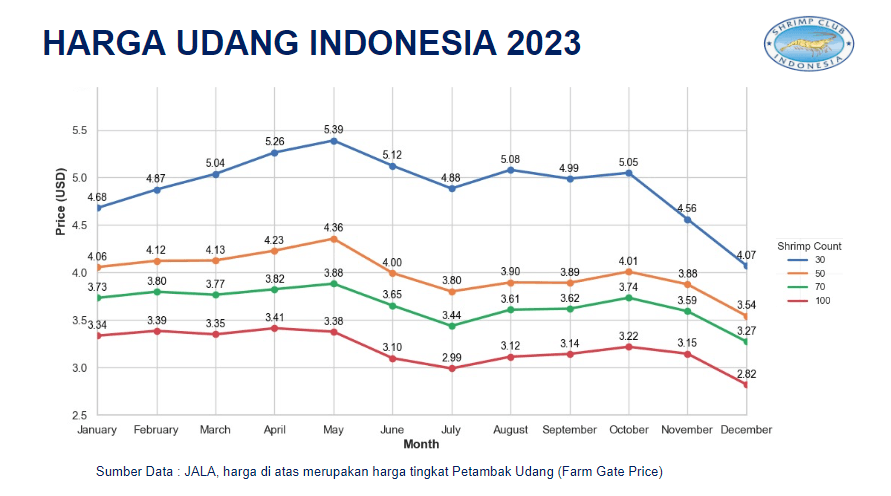
Despite its popularity, the vannamei shrimp industry still has various challenges. Not only are there technical issues in cultivation, the macroeconomic situation also becomes a serious challenge. The global shrimp market issue has an indirect impact on farmers.
This shrimp industry challenge was the second topic in the 14th Shrimps Talk Webinar held by JALA after previously discussing the importance of CBIB for shrimp farming. The speaker at this session was Haris Muhtadi as Chairman of Shrimp Club Indonesia (SCI).
Shrimp price decline
At the end of 2023, shrimp price in Indonesia kept declining, as shown in Figure 1. This occurrence is caused by a lot of turmoil that decreased shrimp prices at the farmer level.
 Figure 1. Shrimp Price Trend in Indonesia in 2023
Figure 1. Shrimp Price Trend in Indonesia in 2023
Factors behind shrimp price decline
According to SCI’s analysis, there are several factors that presumably cause shrimp decline at the end of 2023. The factors are as follows:
- Global economic condition
- Dependency of export market to the United States (US)
- Decreasing demand from the US
- Production rising in other producer countries
- Anti subsidy (CVD) and anti dumping petition (AD)
- Some cold storage reduces the purchase of shrimp
- Supply and demand imbalance
The industry situation in Indonesia is getting tough due to high competition among other producer countries. Shrimp production in Ecuador, India, and Vietnam is higher although backed with lower production cost.
Production cost is rising
Shrimp industry conditions at farmer level are worsened with rising costs in almost all production variables. Haris presented an estimation of production cost per kilogram of shrimp that must be borne by farmers as follows:
- Shrimp fry: IDR 4,000
- Feed (FCR 1,5): IDR 22,500
- Probiotics and inputs: IDR 5,000
- Electricity: IDR 10,000
- Manpower: IDR 3,500
Although production cost is also influenced by shrimp size and farm location, the aforementioned cost reaches IDR 45,000/kg or USD 2.88/kg in total.
This number is assumed to be under normal production conditions, normal shrimp size, and zero disease infection. If disease-related deaths occurred, the number would be significantly higher.
In light of the fact that size 100 shrimp reaches IDR 48,000/kg and size 50 shrimp IDR 58,000/kg, it can be said that production margins have dropped significantly compared to past few years.
Apart from international issues, the Indonesian shrimp industry is still facing a latent issue that is shrimp disease. Disease will significantly affect production costs.
The impact of shrimp price decline
The decline in shrimp prices has significantly affected cultivation. The impact are as follows:
- Delay in stocking time
- Lowering stocking density
- Delay in farm expansion
- Investors in new farms delay their investment
- Closure of farms in several regions
- National shrimp production has decreased
- Employment in the shrimp industry is declining
Recommendations from SCI
In the light of the problems that occurred, SCI has attempted to recommend solutions to the Minister of Maritime Affairs and Fisheries. SCI came up with these recommendations:
- Opening access to new markets abroad and domestically
- Shrimp logistics bureau (Bulog Udang) for price stabilization
- Ease and clarity in investing
- Simplification of licensing
- Clarity of Regional Spatial Planning
- Provision of infrastructure
- Provision of qualified manpower through Shrimp School
- Farm, hatchery, and cold storage certification
SCI has also encouraged the government to assist the campaign to increase domestic shrimp consumption.
Look forward to the next Shrimps Talk!
The 14th Shrimps Talk received an enthusiastic response from the audiences, as seen from the questions raised about CBIB and shrimp industry challenges. Through this series of discussion, hopefully farmers can run their cultivation in a productive and sustainable way.
If you are shrimp industry actors who wish to get the latest information and insight about the industry and cultivation methods, please look forward to the next Shrimps Talk. Follow JALA’s Instagram account at @jalaindonesia so you don’t miss the update. See you in the next Shrimps Talk!





